The Legend of Lotus Spring 
The Legend of Lotus Spring has more in common with a poem than an adventure game. The big moments are intimate and quiet – feeding a fish, playing a musical instrument, finishing a piece of needlework. There are no puzzles or challenges to overcome. The main action of the game is to remember.
In Lotus Spring, you walk through a palatial garden, dreaming about a lost love. The idea was something intentionally outside the expectations of gaming in the early 2000s. It was originally a project by a group of 3D artists to recreate the old imperial gardens of China, and through happenstance, it became the only title produced by a short-lived company dedicated to making games for women. They created an elegant game that takes you on a short, emotional journey through memory and acceptance.
The artists who made The Legend of Lotus Spring originally couldn’t find a publisher willing to take a chance on their non-traditional idea. Then they crossed paths with Anne-Marie Huurre, a woman who was dissatisfied with the gaming industry and wanted another way forward.
Bed, bath, and CD-ROMs
Huurre was a director and producer at Discis Knowledge Research, an educational software company based in Toronto. She had led the production of the adventure game Jewels of the Oracle, and when she left the company soon after to work on a sequel, she wanted to hire more women developers to work on her new team. But she was dismayed to find that she was struggling to recruit women.1,2 Although there were absolutely women in software development, what’s true is that Huurre was working within an industry culture that was dominated by men, both as developers and as their presumed target audience – men making games for men.2,3 (“Have you been to the game developer’s conference?” she said in a chat interview with About.com‘s Stephen Granade. “It’s just about all guys.”2) Huurre saw a parallel with her experiences in her previous career as a television producer, where she was under pressure to overperform as a lone woman in her field. And now coming out of the development of Jewels II in 1998, she felt “a responsibility to encourage more women to get into the business.”2 She wanted to offer an alternative to the culture of the software industry, where women could see their interests and perspectives too.1,2
So Huurre started Women Wise, a company that would produce software by and for women. Befitting her earlier career, Huurre saw her role as something more akin to a television producer rather than a typical game publisher. She was familiar with the rigors of game production and the business end of software publishing, and Women Wise could tackle those high-level problems, helping smaller game developers refine their products and market them to publishers.4,5 Of course, she had a bigger mission for Women Wise than simply producing games: as the Philosophy page on the Women Wise website spells out, it was all about “encourag[ing] women to use and create new media with a female perspective.”6
Huurre wanted Women Wise to become a philanthropic organization. She planned for the company to give portion of their proceeds to educational programs and scholarships for women interested in technology and to donate free computers to women’s groups.7,8 As part of their mission, Huurre got Women Wise involved with meetup groups for women in tech, like sponsoring WiredWomen in Vermont and speaking at Toronto Webgrrls.9
Their philanthropy doesn’t seem to have gotten much further than that because, as Huurre said in an interview with WomenGamers.com, it depended on their games being successful.7 It wasn’t a tacked-on charity program though; it was baked into the company’s mission, something that’s still unusual in the game industry.
One of the inspirations for Women Wise was Purple Moon, the famous girl game company founded by Brenda Laurel a few years prior in 1996. Laurel designed games at Purple Moon driven by her research on the ways that girls played,10 Huurre wanted to extend that idea to adults, to find the gap between what women wanted to play and what game publishers were providing.3,11 For her research, Huurre says she surveyed 3000 women about what they wanted to see in software,6 and however she worded that survey, her results seem to have conveniently lined up with her own interests: women wanted to play games about romance and self-care, games with less violence and more wellness, maybe about nutrition if that was possible.1,6,11
It’s reductive and perhaps inaccurate to have suggested that this reflects the blanket interests of women, and trying to make such a broad conclusion might just reinforce gender stereotypes. But the point of Women Wise was to provide an alternative to the aggressive masculine stereotypes that were already so prevalent in games and software – to cultivate what the software industry could look like if it was tailored for women instead.
Women Wise had a handful of software titles in development,12 most never released, like Be A Million $ Golfer!, an informational CD-ROM about being a woman in golf.13 The best example of what they were working on was a virtual spa program called Bath, Body & Spirit. Although details are slim, the Women Wise website describes it as a digital bath experience that takes you on an aromatic candlelit bathing journey through time:
Bathing – since the beginning of time women throughout the world have sought out the quiet solitude, comfort and beautifying benefits of the bath. Today, more and more women are looking for bathing, aromatherapy and beauty care products and techniques that recapture this ancient pleasure.
Join us in a sensual, enlightening and therapeutic journey as we visit all things bathing from Cleopatra’s aquatic secrets to contemporary spas and health tips.
Enter our quiet pool of steamy mineral waters and fragrant perfumes and we will transport you through the ages pausing to luxuriate in the many special baths created to rest, restore and rejuvenate you. Turn up the volume on the audio portion and the CD becomes a sound track to immerse you in a rich blend of classical and alternative sound tracks to accompany your private time in the tub. Add candle light and the right scents from a treasure trove of pampering recipes gathered from the four corners of the world and relax.14
Even without that program being released, the description gives you a hint of the specific niche of interest and the New Age-y bent with a tinge of exoticism that typified Women Wise. The world would have been richer to have a virtual bath CD-ROM – if only to experience what a virtual bath would be like – but the themes in Bath, Body & Spirit presage the line of wellness and self-care work that Huurre would go into after Women Wise closed.15 (Anne-Marie Huurre did not respond to an interview request for this article.)
Women Wise wasn’t successful, but the concept was radical. The company didn’t have a direct influence on gaming, but in modern independent games about love and care, you can see an echo of the same ideals behind Women Wise, a response to what perspectives, ideas, and voices are seen missing from games.
Which brings us to The Legend of Lotus Spring, the only commercial title that Women Wise produced. The developers of Lotus Spring had their own unlikely backstory that didn’t quite fit into the game industry, this one from a place of art and history.
The Garden of Perfect Brightness
It started out as a project to revive a lost cultural landmark.
During the Second Opium War in 1860, the British and French destroyed Yuan Ming Yuan, the imperial gardens of Qing dynasty in China. Lifeng Wang and his small team of 3D artists called the burning of Yuan Ming Yuan “one of the worst acts of cultural vandalism in recorded history,” and over a century after the destruction, the team wanted to “bring Yuan Ming Yuan back to life.” Reconstructing the entire 865-acre gardens would be unfeasible in real life, but using extensive historical research, they could restore them in a virtual space. With support from the University of British Columbia, the team rebuilt a digital version of Yuan Ming Yuan in exquisite detail, even modeling the interior furnishings. It wasn’t just a neat project to them: they considered the project a form of remembrance – a way to “restore lost culture and history.”16
(If you want to read more about their process, like the software they used, check out the academic article that the team published about the project.)
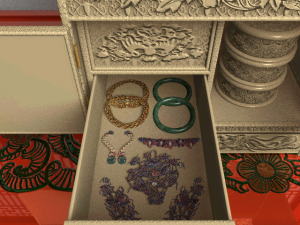
No wonder the project took so long: Lifeng Wang’s team reconstructed the gardens down to the jewelry in each of these drawers
The Yuan Ming Yuan project took considerable time and resources, especially the research and modeling for all the interior decorations. By the end of four years, the team estimated they had only finished rendering about 10% of the gardens. They wanted to continue building it to its full scope, but they needed funding, so Wang started the company Xing Xing Computer Graphics to develop commercial uses for the project. The plan was to keep working on the gardens as part of a series of multimedia computer programs, starting with a historical romance game, The Legend of Lotus Spring.16
As Huurre tells the story, she learned about Lotus Spring while she was consulting for another game publisher. They had rejected Lotus Spring, as had a number of other companies, for the same reasons the game was intriguing to her: it was closer to a romance novel than an action game.11,17,18
Women Wise knew just who would be interested. They brought the game to DreamCatcher Interactive, a publisher that specialized in adventure games at a time when the genre’s popularity was waning. Huurre had previously worked with DreamCatcher on the Jewels series, and they were a perfect fit for Lotus Spring: they had a track record for taking risks on lower-budget games by new developers, and most notably, Huurre says they were among the few publishers she knew that valued and prioritized women, who they estimated made up 60 percent of their audience. DreamCatcher was also the only publisher that supported Women Wise.11,17,19 Although that might have been because of their existing relationship – how else would this small, untested company running against the industry’s marketing practices get their foot in the door? – it’s still significant that they partnered together.
Although I don’t want to dwell on it, it’s worth considering the response to The Legend of Lotus Spring when it was released in 2000. Smaller publications like Mr. Bill’s Adventureland were receptive to the idea of a gentle, romantic game,20 but the only major gaming press outlet that covered The Legend of Lotus Spring was targeted to men. IGN, one of the biggest video game websites at the time, published a bizarre, rambling, sexist review of Lotus Spring that declared the game unfit for “the testosterone-heavy hardcore gaming masses.” The male reviewer, who practically admits he should not have been the person to review the game, goes out of his way to express disgust for concepts even tangentially related to femininity, like scented candles, romance novels, and, confusingly, Kathie Lee Gifford. For context for this editorial voice, consider that IGN still had an embarrassing “IGN For Men” section at the time.21
That response is at the extreme end of negative opinion. It doesn’t represent everyone who played games, least of all the audience that DreamCatcher had cultivated, although it speaks to the belligerent male voice that was prominent (and still exists) in gaming, which felt threatened by the existence of a single game targeted to someone else. This is the atmosphere that Women Wise, Xing Xing, and DreamCatcher were working within.
Understandably, Women Wise attempted to reach their audience through other channels instead, like alternative retail outlets and women’s publications.19,22 They marketed it as a romantic gift, releasing the game on Valentine’s Day and including a gift tag in the box.23 But even then, Huuree received pushback in the other direction, being told by several women’s magazines that women were not interested in games.19 In that environment, the concept of games by and for women had trouble garnering support from allies too.
Under these circumstances, it’s a success by itself that Women Wise, Xing Xing, and Dreamcatcher found and supported each other. Together, they delivered a unique vision that broke from convention – a heartfelt historical romance; a game that dwells on the personal nature of places, things, and feelings; and a story about the healing power of memory.
Coming back to Yuan Ming Yuan
Before you play The Legend of Lotus Spring, make yourself a pot of jasmine tea. The narrator of the game describes the fragrance of jasmine and gardenia blowing through the gardens, and what better way to experience it than by bringing that scent into your home? This might be one of the only games that would actually benefit from Smell-O-Vision.
As the game opens, Emperor Xian Feng has arrived by boat at Yuan Ming Yuan. He is lost, emotionally, mourning the loss of Lotus Spring, the woman he loved. She belonged to the Han people, and by the ruling Manchu edicts of the Qing dynasty, they could never marry. But they still loved each other. The empress dowager disapproved of their romance, and in a fit of envious rage, she had Lotus Spring confined to an island in the gardens. Lotus Spring lived there in splendor, but she would never see the emperor again.
After a long time away from the gardens, Xian Feng heard rumors that Lotus Spring had drowned herself. He has returned to Yuan Ming Yuan to seek closure and relive their memories, rediscovering the remnants of the lives they left behind.
(The game says that Lotus Spring was the emperor’s concubine, which raises concerns about what sort of relationship the game is romanticizing. I’m taking the game at face value that despite other possible implications, this was only meant to be a story about star-crossed love.)
The emperor carries a book with him titled Dreams Of Lotus Spring. Each page contains a drawing of a moment they shared – like painting together or gazing at the stars. Over the course of a single day from dawn to night, as you walk through the gardens, you fill in the pages of the book with the memories you revisit, until at last you reach the island where Lotus Spring lived in solitude. When the emperor finds Lotus Spring’s tear-stained handkerchief at the water’s edge, he realizes that they will truly never see each other again. Yet staring across the pond blanketed by lotus flowers, he knows how deeply they loved each other and how much those memories will still matter if he carries them in his heart.
The Legend of Lotus Spring is overflowing with heartache. Every room in Yuan Ming Yuan is steeped with memories. A flute melody drifts through the air like a breeze. It is a serene place, still and quiet and dewy, the air of the estate thick with the melancholy that comes with revisiting a lost love. Xing Xing Computer Graphics made a sumptuous recreation of Yuan Ming Yuan, and the interiors, which took so much of their time and resources, feel like we’re picking them up right after they were abandoned in mid-use. The cups and dishes from the tea sets are still out on the tables, waiting for the ghosts of the lovers who once lived here to drink from them again.
The world can feel empty and at times devoid of purpose, fitting the fact that it was adapted from a model of the gardens which was lavishly created without a narrative or function in mind, but the scenes you walk through in The Legend of Lotus Spring are beautiful in their ordinariness. When you step aboard the vacant Marble Boat and find a picnic box, you can unpack it one layer at a time, clicking on each basket of tea cakes and dumplings. In another house, you light a stick of incense and watch it silently burn, or you can water a plant. The game is a series of these intimate moments with objects from an old life.
These mementos and the tea sets and candles are based on things that would have been in the real imperial gardens, and the game still incorporates the historical mission behind the reconstruction of Yuan Ming Yuan. On a separate screen, the game explains the background and purpose of the objects you interact with, sometimes with a mixture of folklore and functionality. Though it’s easy to miss this information, there’s a clever symmetry between the narrative of this game and the original reason the game exists. The emperor is retracing his days with Lotus Spring before she was cruelly taken away; you are remembering Yuan Ming Yuan before it was cruelly taken away too.
It’s surprising that the first and only title from Women Wise is about a woman who’s imprisoned and dies, told from a man’s perspective. But the way the whole game is centered on its emotions was so different for the time, even within the quieter mold of the adventure genre. It was different even compared to other games from DreamCatcher, which are more about mysteries or secrets. (A closer comparison would be a modern narrative adventure game that tells personal stories through the environment.)
The focus of the Lotus Spring isn’t mastery, discovery, or victory. It’s a meditation on the fragility of life.
“Although there is pain in saying goodbye,” the narrator says, “there is acceptance and joy as well.” Coming to terms with his loss, the emperor writes one final epigram in his dream book: “The life in which we part forever is not for grieving.” Instead of reuniting with Lotus Spring, you find solace – the ability to cope with a tremendous loss and absolve yourself of guilt through the strength of memory. The Legend of Lotus Spring is a game of remembrance – and the game is an act of remembrance itself.
References
1. WomenGamers.com. (n.d.). TOPIC: Legend of Lotus Spring: the game that targets women [Page 1]. Retrieved from https://web.archive.org/web/20041224042640/http:/www.womengamers.com/interviews/lotus.php
2. Granade, Stephen. (2000, March 2). Chat With Anne-Marie Huurre [Page 5]. About.com. Retrieved from https://web.archive.org/web/20000914042553/http://interactfiction.about.com/games/interactfiction/library/chat/blannemariechat5.htm
3. WomenGamers.com. (n.d.). [Page 2]. Retrieved from https://web.archive.org/web/20041224024854/http:/www.womengamers.com/interviews/lotus2.php
4. Granade. (2000). [Page 3]. Retrieved from https://web.archive.org/web/20000914042544/http://interactfiction.about.com/games/interactfiction/library/chat/blannemariechat3.htm
5. Women Wise. (n.d.). Producer’s Journal. Retrieved from https://web.archive.org/web/20010217052427fw_/http://www.women-wise.com/entertainment/jewels2/producers-journalframe.html
6. Women Wise. (n.d.). Philosophy. Retrieved from https://web.archive.org/web/20010418201357/http://www.women-wise.com/philosophy/philoframe.html
7. WomenGamers.com. (n.d.). [Page 5]. Retrieved from https://web.archive.org/web/20041224042212/http:/www.womengamers.com/interviews/lotus5.php
8. Women Wise. (n.d.). Lifelong Learning. Retrieved from https://web.archive.org/web/20010428190428/http://www.women-wise.com/community/lifelongframe.html
9. Women Wise. (n.d.). Corporate News – Public Relations. Retrieved from https://web.archive.org/web/20010424191530/http://www.women-wise.com/corporate/publicframe.html
10. Kocurek, Carly A. (2017). Brenda Laurel: Pioneering games for girls. New York, NY: Bloomsbury Academic, 17-20.
11. Granade. (2000). [Page 2]. Retrieved from https://web.archive.org/web/20000914042540/http://interactfiction.about.com/games/interactfiction/library/chat/blannemariechat2.htm
12. Women Wise. (n.d.). Entertainment – More to Come! Retrieved from https://web.archive.org/web/20010419162228fw_/http://www.women-wise.com/entertainment/moreframe.html
13. Women Wise. (n.d.). Be A Million $ Golfer! Retrieved from https://web.archive.org/web/20010428181236fw_/http://www.women-wise.com/entertainment/golf/golfframe.html
14. Women Wise. (n.d.). Bath, Body & Spirit. Retrieved from https://web.archive.org/web/20010428191740/http:/www.women-wise.com/entertainment/bath/bathframe.htm
15. Healing Caregivers. (2019). Retriever August 18, 2019 from https://healingcaregivers.com/
16. Wang, Christine, Wang, Lifeng & Fournier, Alan. Envisioning Yuan Ming Yuan (Garden of Perfect Brightness). (2000, January/February). IEEE Computer Graphics and Applications, 20, 10-14. Retrieved from https://www.computer.org/csdl/magazine/cg/2000/01/mcg2000010010/13rRUxYIN6L
17. Granade. (2000). [Page 1]. Retrieved from https://web.archive.org/web/20000819023744/http:/interactfiction.about.com/games/interactfiction/library/chat/blannemariechat.htm
18. WomenGamers.com. (n.d.). [Page 5]. Retrieved from https://web.archive.org/web/20041224042047/http://www.womengamers.com/interviews/lotus3.php
19. WomenGamers.com. (n.d.). [Page 5]. Retrieved from https://web.archive.org/web/20041224025131/http://www.womengamers.com/interviews/lotus4.php
20. Mr. Bill and Leta. (2000, February). The Legend of Lotus Spring. Mr. Bill’s Adventureland. Retrieved from https://web.archive.org/web/20200505011443/http://www.mrbillsadventureland.com/reviews/k-l/lotusspringR/lotusspringR.htm
21. Peterson, Erik. (2000, April 24). The Legend of Lotus Spring. IGN. Retrieved from https://web.archive.org/web/20000510171129/http://pc.ign.com/reviews/14512.html
22. Women Wise. (n.d.). Marketing. Retrieved from https://web.archive.org/web/20010223130502/http:/www.women-wise.com/corporate/marketingframe.html
23. Granade. (2000). [Page 4]. Retrieved from https://web.archive.org/web/20000914042540/http://interactfiction.about.com/games/interactfiction/library/chat/blannemariechat4.htm

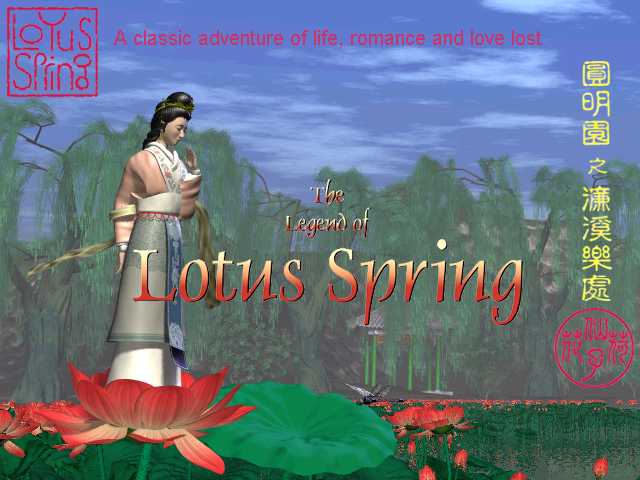



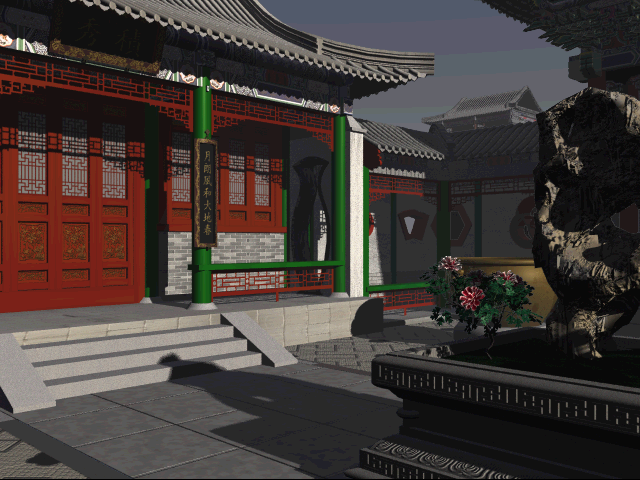
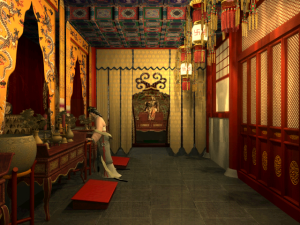
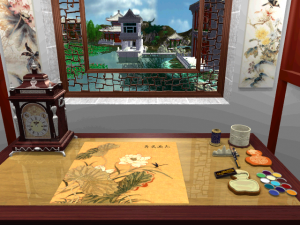
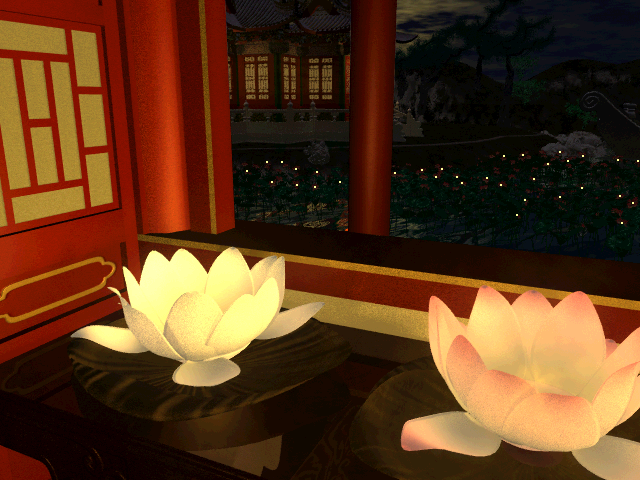
The 3D scenes and textures are stunningly exquisite. They have that funny 90s Bryce vibe to them, like the lack of shades of white/grey in the screenshot of the desk. I wonder if it’s possible to freely walk through them in the first-person, using today’s technology, and keep that level of detail?
There’s a few places where the detail would like faker in real-time. There’s a scene at a banquet table where the food looks great, but it’s clearly flat photographs of actual food. Those details could be redone, but I think a bigger problem would be the few larger areas in the game that are extremely dense with detail. The one that comes to mind is Lotus Spring’s personal quarters on the island, which has a ton of knickknacks and statues on the walls.
I couldn’t figure out where to work this into the article, but Xing Xing planned for one of their future projects to be an online real-time 3D version of the gardens using VRML (a web-based 3D format). Even though that didn’t pan out, I have no idea how they planned to do that with 2000-era technology (in a web browser!), but maybe they had way in mind to scale down the detail. Or more likely it was a pipe dream.
Mr Bill’s Adventureland seems to have become a spam blog. May want to archive.org that URL
What a fantastic article about a beautiful, unappreciated game. In those days any game even slightly out of the ordinary was ridiculed. Such a shame.
Oh no, that’s too bad about Mr. Bill’s Adventureland! I was glad they had stayed online for so long. Thanks for the heads up, I’ve updated the link.
This game is one of its kind, a very unique game that maybe different from other games you have played. Only thing about this game that i don’t like is its confusing camera, sometimes it’s a 180 degree turn , sometimes its a 90 degree turn.